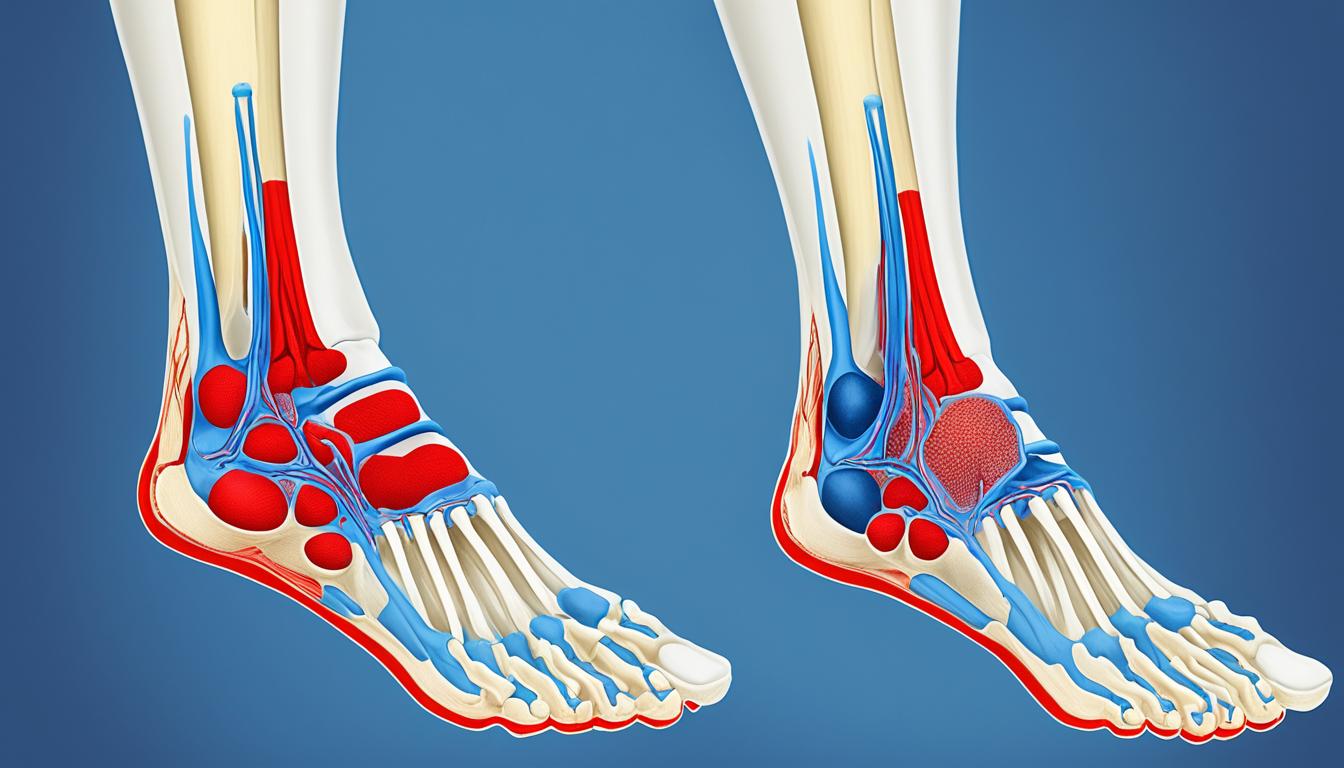Pes planus is known as flat feet or fallen arches. It’s marked by the collapse of the foot’s arch. This makes the arch flatten, the heel bone turn out, and the front part of the foot move away from the back. It can happen to one or both feet. Severe cases might also involve the ankles.
Injuries like fractures or issues with the foot’s tendons can lead to pes planus. Risk factors include diabetes, being overweight, and specific bone and joint diseases. It can also be caused by inflammation disorders that test negative for certain markers.
People with pes planus might feel pain in their feet, ankles, legs, knees, hips, or back. Their foot may also point inwards more than usual. Doctors check for this condition by looking at symptoms and doing physical exams. They might use X-rays or MRI scans too.
Treatment can involve exercise and wearing the right shoes. But new methods like stem cell therapy are also being used more often.
Key Takeaways:
- Pes planus is a foot condition characterized by the collapse of the arches.
- Causes can include injuries, dysfunction of the posterior tibial tendon, and risk factors such as diabetes and obesity.
- Symptoms may include foot and ankle pain, leg, knee, hip, or back pain, and overpronation.
- Diagnosis is based on clinical assessment and medical history, sometimes with additional tests like X-rays or MRI scans.
- Treatment options range from non-surgical approaches like physiotherapy to innovative therapies like stem cell therapy.
Causes and Risk Factors of Pes Planus
Flat feet, or pes planus, happen due to many reasons. One main cause is when it runs in the family. Sometimes, foot bones do not grow right before birth, leading to flat feet. This is usually because of bone growth issues or bone fusion in the foot arch.
Conditions like joint hypermobility syndrome can make flat feet more likely. This syndrome weakens the connective tissues that support the arches of your feet.
If someone has nerve or muscle problems, they might develop flat feet too. These issues can affect how the arches of your feet work, making them flat.
Several risks can make you more likely to develop flat feet. These include foot injuries, being overweight, and having diabetes. Injuries to your foot can harm the structures that keep your arches up, causing the feet to flatten.
Knowing the causes and risks of flat feet is key for diagnosing and treating it. Doctors can create treatments that target these factors. Doing so helps manage flat feet and ease any discomfort they cause.
Common Causes and Risk Factors of Pes Planus
| Cause/Risk Factor | Description |
|---|---|
| Inheritance | An inherited tendency to develop flat feet |
| Foot Bone Problems | Abnormalities in bone growth or fusion of bones forming the arch of the foot |
| Connective Tissue Disorders | Disorders affecting the connective tissues supporting the foot arches |
| Nerve or Muscle Conditions | Conditions impacting the muscles and nerves responsible for foot arch function |
| Trauma | Injury to the structures involved in maintaining the foot arch |
| Obesity | Excessive weight placing strain on the foot arches |
| Diabetes | Affected nerves and blood vessels compromising foot arch integrity |
Symptoms and Diagnosis of Pes Planus
Pes planus is another name for flat feet. It brings a lot of symptoms that can affect more than just your feet and ankles. You might feel pain in your legs, knees, hips, or back because of it.
Common signs of pes planus include:
- Foot and ankle pain: You might feel sore or painful in your feet and ankles, especially after using them a lot.
- Overpronation: This happens when your feet roll too much inward as you walk or run. It can mess up your balance.
- Limited range of motion: Pes planus affects how well you can move your foot and ankle. This can make you less flexible and stable.
- Leg, knee, hip, or back pain: Bad foot alignment from pes planus can cause pain in your lower body. It might even affect your back.
Doctors diagnose pes planus by talking with you about your medical history and checking your feet. They look for tenderness on the posterior tibial tendon, often sore in people with flat feet. They also watch your feet to see if they roll too much inwards. Plus, they test how well you can move your ankles and feet. Sometimes, you might need X-rays or an MRI to confirm the diagnosis.
Once they understand and diagnose your pes planus, healthcare pros can create a plan to treat it. This plan will address your specific needs.
Treatment and Management of Pes Planus
The treatment of Pes planus varies based on its severity and the signs shown. The first treatment option usually avoids surgery. It focuses on physiotherapy to help with foot movement, strengthen nearby muscles, and enhance control of the foot and ankle. The goal is to fix any imbalances and get the foot properly aligned.
People with flat feet should also use supportive footwear such as arch supports or orthotic inserts. These reduce symptoms and offer more stability and support. Choosing shoes that fit well is key in handling Pes planus and avoiding more problems.
Innovative therapies have started to change the game for treating Pes planus, with stem cell therapy showing potential. This treatment uses stem cells to help fix and regrow tissues in the foot. By putting stem cells where they are needed, this therapy boosts the healing process and foot function.
If non-surgical options do not work or if the condition is severe, surgery might be needed. Surgery works to fix the foot’s structural issues or it repairs damaged tissues to bring back the foot’s natural arch. It is vital for those with Pes planus to consult with health specialists. They will help pick the best treatment plan for each situation and goal.

